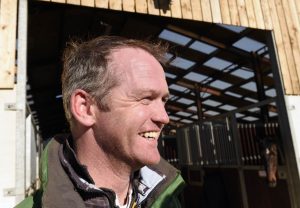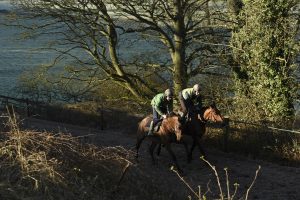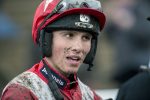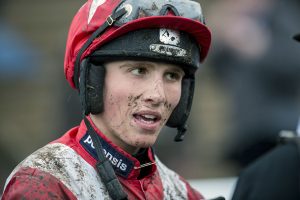How do you successfully combine the jobs of assistant trainer of some 85 horses as well as managing 700 acres of Dorset farmland, which includes about 600 head of cattle?
The farm is well set up and I have three very good guys working for me. I am in the milking parlour just after 6am to make sure everything is fine for the dairyman. In winter it’s pretty straightforward because there are just chores to do in the day-to-day running and I can leave them to get on with it. On days when I am not racing I can get more involved.
Dad and I have a meeting at 6.30 every morning over a cup of coffee in the kitchen where we discuss plans for the farm and the horses. We are lucky to have excellent staff and it all blends in quite well because we are busy with the horses in the winter, whereas there is more to do on the farm in summer with the silaging. Though the tractor work is left to contractors these days.

Tizzard is enjoying life as an assistant trainer
I am up at the horse yard by seven and will ride out a couple of lots and go racing three or four days a week. I have to admit there was a blip about eight years ago when I made a stupid mistake while driving a big baler, got tangled up in the machinery and was lucky not to have my head taken off.
To what extent are you involved with the actual training and preparation of each individual horse?
I am involved more so than ever, going through entries with dad, either riding out or on the gallops with him. I help with the decs and agents ring me as much as they ring dad. We were underbidders, at 510,000gns, for Harlem, the Horses in Training sales-topper in October on behalf of Mr [Alan] Potts.
Finding and buying the right horses is so important. I ride a different horse every day, particularly those that are getting close to a run to see if I think they’re ready. There’s nothing in the horse business that doesn’t include me.
You became assistant trainer to your father the moment you retired from race-riding in 2014, aged 34. How easily did you come to terms with quitting the saddle and the change of lifestyle?
It was a huge change from the riding side of things, but not from the day-to-day business because I’ve never been far away from home, where there’s always been plenty to do. I did miss the race-riding, but it was my decision at the right time for me to become even more involved in the business.
In the late 1990s you burst on to the scene as a teenager with Paul Nicholls, riding top-class horses and winning a string of big races. Could you fully appreciate all your achievements – and the quality of horses – at such a young age?
I appreciate it all a lot more now than I did at the time. I turned professional at 18 and rode 91 winners that season, including Grade 1 winners. I was naïve and blase enough to think they would all win whenever I got on a Paul Nicholls horse – and many of them did. When I broke my back in 2002 I had time to take stock of everything and I began to appreciate how lucky I had been.
You then realise you’ve got to work really hard to get back to those good times. I don’t regret any of it. A part of me thinks I was a better rider later on as a result of all the experience. That young naivety is a massive plus at the time, but you don’t have the experience to go with it.
Flagship Uberalles was an outstanding two-mile chaser in those early days. What kind of horse was he to ride in the big races?
He was very straightforward, a push-button horse. He never used to pull and was a superb jumper. Those good horses are often the easiest to ride because they don’t do anything wrong. He was a gorgeous, gorgeous horse with bags of scope so if you ever needed a big jump to get you into a race he’d give it to you.
Despite considerable early success, your partnership with the Nicholls stable ran out of steam. Any regrets?
I have no regrets at all. I am not that sort of person. I am still in the fortunate position of being great friends with Paul. At the time he had 60-70 horses and was moving up through the training ranks and was getting bigger and bigger, with owners like Robert Ogden, who retained Paul Carberry.
I rode the best part of 500 winners for Paul. There were times when I’d get a bollocking if a horse had run badly and I’d feel a bit sorry for myself. But if I could go back in time I’d do it all again. Nothing lasts forever.
Jockeys – even former jockeys – are said to be their own worst critics. How would you evaluate your own strengths and weaknesses as a rider?
I always felt that horses jumped well for me; I was certainly a better chase jockey than I was over hurdles. I’ve been hunting and jumping all my life and I always felt I could get horses jumping as well as anybody.
It’s not really a weakness, but I was plenty tall enough, at six foot, and not the right size or shape to be a jockey, permanently dieting for 18 years. I was too big for some of the little hurdlers. My passion is horses and I ride every day of the week whether I have to or not. If there’s nothing to ride in the yard in summer I’ll jump on my hunter and hack round the farm.
I’d like to think we’ll eventually have a hand-over in similar style to the Hannons
What do you miss about race-riding?
There’s nothing that can replace the thrill and adrenaline of being a jockey. I just miss the buzz. All jockeys are adrenaline junkies and we are addicted to it. I was getting that three or four times a day when I was riding. I’d even have a heavy fall and get a kick from it; not the horse, hopefully! When I’d pick myself up off the ground I would have that buzz.
When I go hunting and jump a huge hedge it’s that same feeling again, something I used to live off when I was race-riding. I even have a motorbike on the farm now so I can go fast, and that can give me quite a thrill. My weight has gone up a stone and a half to 12st and levelled out there. But I held it at 10st 7lb for 18 years.
Do you have one outstanding memory of your riding career?
I’ll never forget my first winner as a 17-year-old over the Grand National fences on With Impunity in the 1997 Sefton Chase for amateur riders. He jumped like a stag and had scope to burn. It was only a five-runner race and we made all. He hit the first and after that never touched a twig. I was sending him into every fence and he just stood off outside the wings. I’ll never forget the feeling of being in the air for seconds at a time; we’d just go up and float before hitting the ground running.
You joined the Nicholls stable as a 16-year-old and understand his set-up better than most people. In what way has the Nicholls success formula rubbed off on the Tizzard training methods?
We have copied Paul to suit our own system and set-up. We have got a lot of Paul’s ideas and he was never shy about coming forward and offering his thoughts. Paul doesn’t complicate things. We feed in the same style and, like him on a day-to-day basis, we don’t trachea wash, blood test or take temperatures. We believe if the horse looks well, is eating well and is working well then he’s ready to go. If a horse runs disappointingly then we have to take tests.
It is not always easy to work with family. Your sister Kim is also part of the business, along with your mum Pauline. How do you all get on?
We do get on well together, though when I was no longer the jockey and at home permanently there were a couple of niggly things as we were finding our feet. But now everybody knows their role and their opinions get listened to, though ultimately the final say is down to Dad.
We all know each other inside out and recognise what we’re trying to achieve. It works really well. Mum does the secretarial work for the farm and Kim does all the bills in the office with Debbie, the office secretary.
Are you in a hurry to have your own training licence or take over from your father?
No, not at all! I’d like to think we’ll eventually have a hand-over in similar style to the Hannons, who eventually passed the baton smoothly from father to son. Everybody knows they can speak to me at any time. Dad’s answerphone says if he’s not there ring Joe. I’m in no rush to have the licence in my name and dad’s in no hurry to hand it over.
When you retired you said, “I’ll still be very much part of Cue Card, I just won’t be the man riding him”. How involved are you with him now?
I ride him about once a fortnight, or whenever I need to just to see how he is. Before he ran at Wetherby I gave him a racecourse gallop. But Hamir Singh, who looks after Cue Card, goes out on him every day accompanied by my sister Kim on Theatre Guide. They’ve been doing that together at the head of the string for the last two years.
Cue Card is a very special horse with a huge amount of ability. He was a bit keen in his early days, but now he’s settled and relaxed and is the best horse you could ride up our gallops. He’s completely the opposite to Thistlecrack, who pulls out a bit lazy and takes time to warm up. Cue Card comes out, walks fast, head in his chest loving every second of every day. He gives you the best feel at home and no horse gets near him.
His reappearance in the Charlie Hall at Wetherby sharpened him up. We probably got the tactics wrong but were really pleased with his run and it’s going to take a good one to beat him.
Thistlecrack is one of the most exciting horses in training, yet he only started racing over hurdles aged seven following three runs in bumpers. Why was that?
He had some niggly problems and was a big, weak baby who could barely handle our gallops as a four- and five-year-old. He used to pull muscles in his pelvis as easy as anything. His owners, John and Heather Snook, are big farmers and stock people and agreed to give Thistlecrack time, allowing the horse to tell us when he’d be ready to be trained. Thanks to their patience, we’ve now got this exciting horse.
They understand livestock and were happy to back off and let the horse grow into himself and fill out. It was the season before last after I gave him a two-mile gallop round Wolverhampton that I realised, ‘This is a serious horse’. Then last year Thistlecrack took it to a whole new level and we never got to the bottom of him.
Was it your father’s decision to aim Thistlecrack at the Gold Cup in his first season chasing, or was it a joint agreement to go straight to the top with him?
Not completely Dad’s as it is a decision that has been discussed over and over by ourselves, the Snooks and plenty of people whose advice we hadn’t even asked for! John and Heather bought him to win a Gold Cup, which we think is the pinnacle of racing. He is going to be a nine-year-old next year and we thought if he takes to fences we’ll give him enough experience in the first two-thirds of the season for the Gold Cup.
He won well at Chepstow [on his chasing debut] and he was A1 after his second chase at Cheltenham; Thistlecrack will have learnt from his mistakes and be better in a more competitive race. The plan is to go to Newbury’s Hennessy meeting and then probably the Feltham at Kempton en route to Cheltenham.
Can you compare Thistlecrack with Cue Card? What are the basic differences between them?
Cue Card is a lighter-framed horse and he’s a much easier mover than Thistlecrack, who is more of a beast, a bigger, stronger barrier type horse that eats the ground. Cue Card floats over the ground whereas Thistlecrack pulls the ground towards him.
They’ve both got the mentality of good horses who come alive when they get to the races. Thistlecrack can be half asleep at home but on the racecourse he is totally different. These top-class horses can’t be meek; they have to be tough to be continually competing at the top level. We are spoilt having the two of them.

Joe Tizzard puts Thistlecrack through his paces on the gallops, right nearside
Last year the Tizzard training stables moved up the hill from Venn Farm to Spurles Farm, the recently purpose built stables high on the Dorset-Somerset border. How beneficial has the new situation of the premises been for the horses?
We built it on top of a hill so it can absorb as much air and light as possible, making it a healthy, bug-free yard. We don’t mind it being a bit colder up there as we can put an extra rug on the horses. We just want them to be in the fresh air, no draughts, just an airflow all the time. It makes for a beautiful working environment. The horses had been encroaching on to the farm but now they are completely separate.
Recently you were sent 15 horses by Alan and Ann Potts, who also purchased exciting chaser Fox Norton to join your stable. How big a boost is this to the operation and how high can the Tizzard stable aim?
We got the phone call from Mr Potts in September and they sent us a cracking bunch of horses, 11 of which have already run, plus four babies. We finished fourth last season and to be honest I think we’re 50 horses short of being competitive in the race to be champion trainer.
But our quality of horse gets better every year. Mr Potts is always looking for Cheltenham prospects and we have a horse in the yard to run in big races every weekend. We’ll be disappointed if we don’t finish in the top five again.
Fox Norton was very impressive at Cheltenham but we can’t take the credit; he came to us fit and well and looking an absolute picture from Neil [Mulholland]. He’s put himself right in the Champion Chase picture.
Of course the Tizzard stable does not revolve solely around Cue Card and Thistlecrack. So can you give us another chaser and hurdler to follow this winter?
Two hurdlers are West Approach, Thistlecrack’s half-brother who finished second at Cheltenham in October, and Elegant Escape, a gorgeous horse who won his first novice hurdle at Chepstow. Robinsfirth, who’s going novice chasing, missed 18 months but is back in and looks great.



